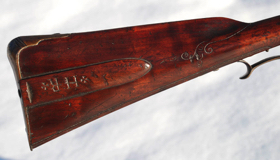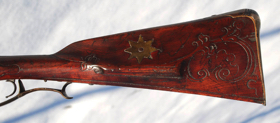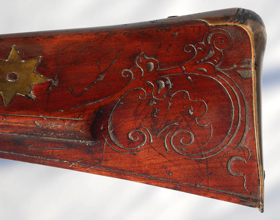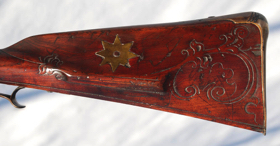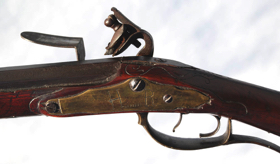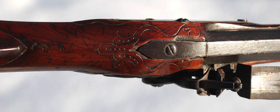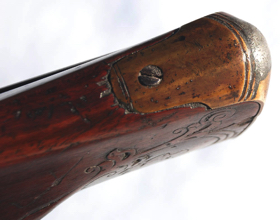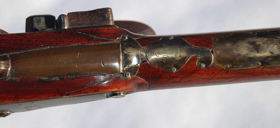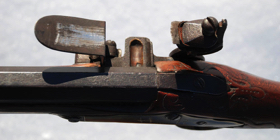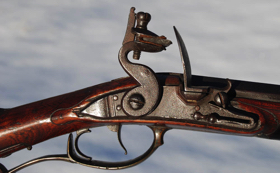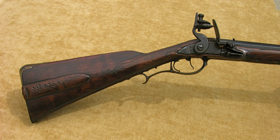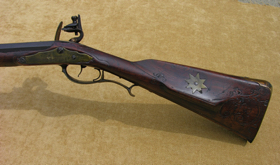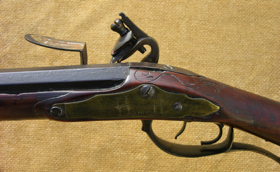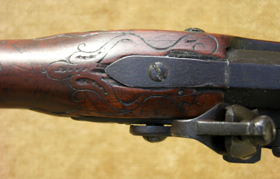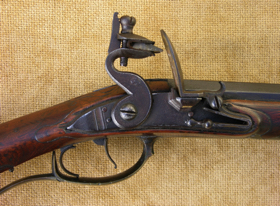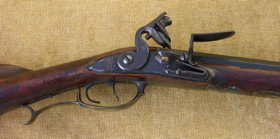As I see it, this just may be what I would term an 'arsenal' rifle, as it appears quite hasty yet competent. The scenario I would present revolves around it having been stocked out of parts ca. 1777-1779 while Allentown was crowded with Philadelphia evacuees and a state arsenal, or gun repair and fabrication facility, was organized there [See “John Tyler, Ebenezer Cowell and Sixteen Unknown Workmen” within the articles located elsewhere upon this site]. It appears petite in some ways but in reality is a fairly big, wide gun. In the spirit of a true ‘parts gun,’ the buttplate has been cut-down from a fowler butt and has a plugged screwhole at the rear, evidently reused and installed quickly at something of an awkward angle. The lock - obviously utilizing a replaced cock and frizzen of disparate proportions - represents a recycled German lock, and the sideplate has been cut-down from a larger and earlier sideplate. It too was recycled as the tail has been cut-off, the rear lock nail hole is filed out in a large manner to accommodate movement and the nose is chopped. There is still a hint of the original screw hole in front of the forward lock nail! The handmade set triggers carry an original appearance but at some point the gun surely had a different triggerguard installed as there are faint remnants of a disparate mortise both fore and aft. This particular guard itself seems like a secondary piece as the rear finial was broken and has been riveted back together. Also, all of the sheet brass upon the forearm (the wear plate and folky liberty head inlay) are later additions to cover a worn-through forearm (it is in fact worn through right into the rammer channel). The wraparound nosecap seems to have been at some point removed and reinstalled but not quite in the same place - it's been moved slightly rearwards. Maybe the rivets accidentally pulled? "HR" likely represents a one-time owner, perhaps an individual called up for militia duty to whom the arm was issued? There is an impossibly-faint remnant of a signature on the barrel which at this point can not be made out; it appears to have been in script as some of the tails of the letters drop down over the edge of the top flat. The barrel is rifled at 44 inches long. Also evident is a repair to the toe whereupon at some point in the past a piece sheared-off; it was glued and screwed back in plate and the buttplate re-straightened . The heel has been completely worn-through and is now filled with lead.
The buttplate is almost 2 full inches wide and the wrist is quite wide, approximately 1 5/8" wide but only approximately 1 1/4" tall under the guard. There definitely seems to be some upward dishing there as found upon later Moll/Rupp/Neihart rifles but because it revolves around a relatively straight stock there is no apparent ‘step.’ The lower butt molding, however, abruptly terminates as if it was a step wrist and there is evident curvature - a small amount - to the toe line. Stylistically, the rifle is very much in what is believed to be a style representative of Peter Neihart and it obviously does have some association with the Allentown/Whitehall area. What can be made out of the signature remnant, however, does not seem to match Neihart’s signature. The carving was originally raised but is now worn almost flat with a very smooth, silky feel. The tang carving and what is left of the carving around the entry pipe - and there isn't much left there, between wear and the brass plate - looks different from 'the usual' but I believe largely is representative of a very fast and somewhat mechanical interpretation of regional formula. The native cherry stock has aged to a spectacular and deep, rich ‘antique cherry red’ tone.
If the artificial ‘aging’ of a contemporary rifle can be viewed as something akin to the telling of a story, this rifle surely must be good for a few long chapters at the least! In the creation of such a ‘fake,’ and I use this term with full awareness of the word’s definition of inherent deception, it is the development of the plot and subsequent tale which brings so much enjoyment to the project. From Robert Weil, author of Contemporary Makers of Muzzleloading Firearms: “...by going to this extreme I think you cross over from utilitarian/art, to pure art... This is an interesting direction. Near the very edge of the contemporary scene as you put the collector/consumer into the same basic role of the antique guys... I think the whole ‘aging /what-if’ thing is most compelling. It's really making art out of a look backwards and forwards - all in the same moment.”
